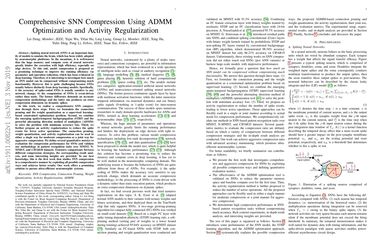Comprehensive SNN Compression Using ADMM Optimization and Activity Regularization
As well known, the huge memory and compute costs of both artificial neural networks (ANNs) and spiking neural networks (SNNs) greatly hinder their deployment on edge devices with high efficiency. Model compression has been proposed as a promising technique to improve the running efficiency via parameter and operation reduction. Whereas, this technique is mainly practiced in ANNs rather than SNNs. It is interesting to answer how much an SNN model can be compressed without compromising its functionality, where two challenges should be addressed: i) the accuracy of SNNs is usually sensitive to model compression, which requires an accurate compression methodology; ii) the computation of SNNs is event-driven rather than static, which produces an extra compression dimension on dynamic spikes. To this end, we realize a comprehensive SNN compression through three steps. First, we formulate the connection pruning and weight quantization as a constrained optimization problem. Second, we combine spatio-temporal backpropagation (STBP) and alternating direction method of multipliers (ADMM) to solve the problem with minimum accuracy loss. Third, we further propose activity regularization to reduce the spike events for fewer active operations. These methods can be applied in either a single way for moderate compression or a joint way for aggressive compression. We define several quantitative metrics to evaluation the compression performance for SNNs. Our methodology is validated in pattern recognition tasks over MNIST, N-MNIST, CIFAR10, and CIFAR100 datasets, where extensive comparisons, analyses, and insights are provided. To our best knowledge, this is the first work that studies SNN compression in a comprehensive manner by exploiting all compressible components and achieves better results.
PDF Abstract

